
|

|
"Immigrants and their
supporters were gathering in cities across the country today for demonstrations and an economic boycott intended to show the
impact the workers have on the nation's economy… The demonstrations took many forms and included people from a disparate
number of countries, many of them in Latin America, but also from Asia and other parts of the world." – New York
Times, Nationwide Immigrant Rallies Are Under Way, Monday, May 1, 2006
Hundreds of thousands gathered across the whole country on this Monday to celebrate "A Day Without
Immigrants" - to demonstrate the importance of immigrants to our economy. As has been discussed elsewhere in these pages,
the Senate is considering a bill that attempts to increase border security and offers citizenship to certain illegal immigrants,
and the House has already passed a bill that would erect a giant fence on the border and would make illegal immigrants felons,
and make those that help them in any way, even with shelter and medical assistance, or even a hot meal, criminals also. Our
local Catholic archbishop, Roger Mahoney, has led protests of the House bill, the president sides with the Senate, while the
"social conservatives" and "values" folks side with the House, and Lou Dobbs on CNN is waging a daily one-man jihad against
anything but arresting and deporting the perhaps twelve million immigrants here without papers, and building that wall. The
issue is hot. And people have taken to the streets.
Monday, May Day of 2006, there were massive marches in Los Angeles,
one downtown in the morning, and a second took place in the evening. Between those two there was a massive march along Wilshire
Boulevard, from MacArthur Park west to La Brea (site of the famous Tar Pits). That began at four in the afternoon, so the kids could stay in school and join in after classes.
These photographs
are from the center of it all, Wilshire and Western, around three in the afternoon, as the crowds were gathering, the news
crews were everywhere doing their "live remotes," and the police were rolling in - in their Crown Victoria squad cars, on
motorcycles, and even on bicycles. There were closing off Wilshire Boulevard, the busiest urban corridor in the world.
But
they knew this was not a hostile situation. The mood was downright genial and surprisingly welcoming. Folks mugged for the
camera, people wanted to talk and share food, and everyone was actually happy.
This was a demonstration that seemed
to be in support of the idea that there are millions now who, with great difficulty, made their way here to work and make
something of themselves, and to support the families they loved, and participate in the American Dream, whatever that is.
Yes, they did not follow the rules, but they do work hard, and seem in love with this country - and this May Day they and
their supports wanted to point out the twelve million illegal immigrants are an important part of the economy, and would like
a chance to become "legal" and not be branded as felons and sent away. They believe in this country, and are willing to start
at the very bottom of the system. But they want you to know they really do want to be here, and participating in making this
place better. It was oddly patriotic. The marchers all wore white shirts (no threat) and almost every flag was an American
flag. There wasn't one Mexican flag anywhere, but there might have been later.
The police gathered in small groups
and you could overhear them talking about their own families, or last night's amazing Lakers playoff win in the last microsecond
of overtime, or trading notes on which mirrored sunglasses were the coolest (really, three of them did). The police on bicycles
rode by in groups of fifteen or twenty, waving to the crowd and now and then trying to play tunes with their special whistles,
which didn't work all that well, but made everyone laugh. This was going to be just basic crowd control, with a cooperative
and pleasant crowd. No trouble - just lots of people.
Here's a shot of some of them.
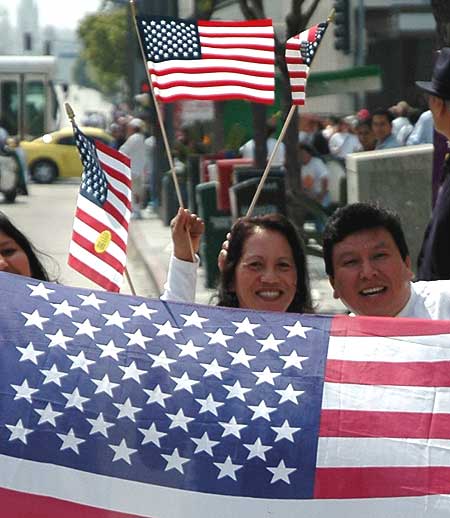
And not everyone was
from Mexico and parts south.
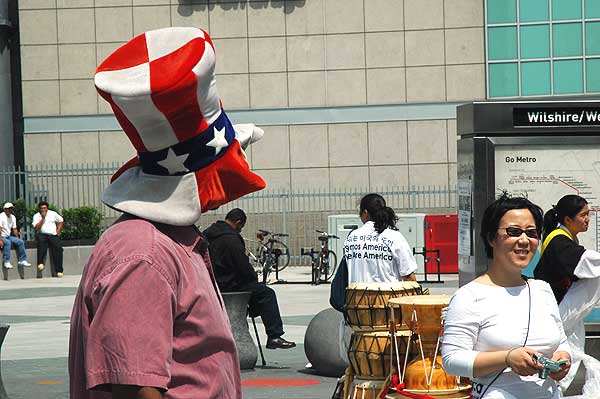
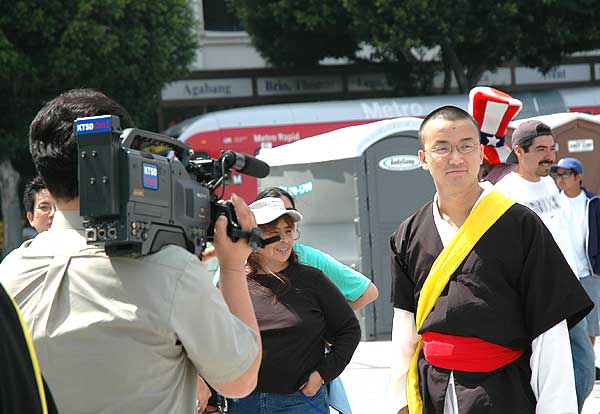
A little bit of the
patriotism –
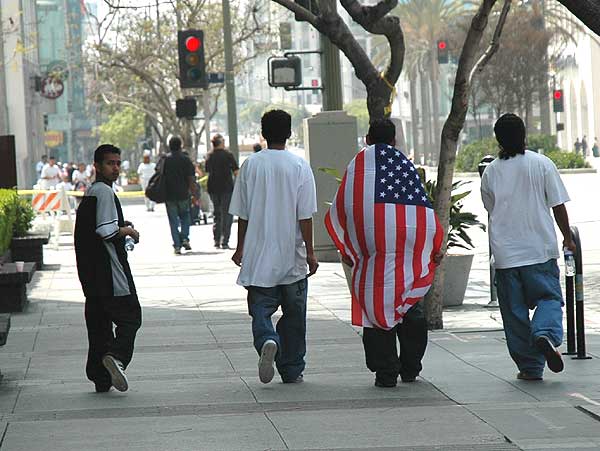
Note the Anglo guy
in the background. He's not happy at all.
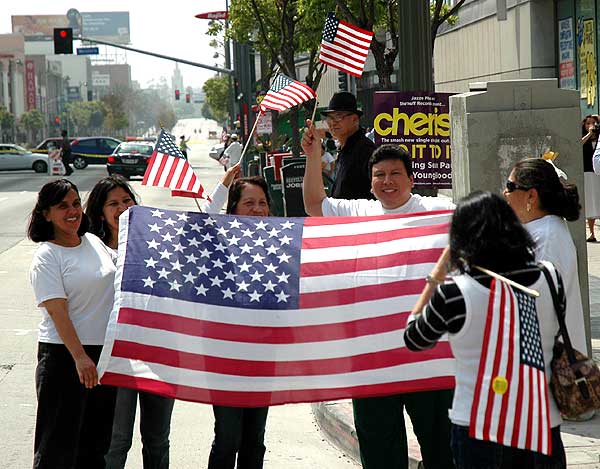
The press –
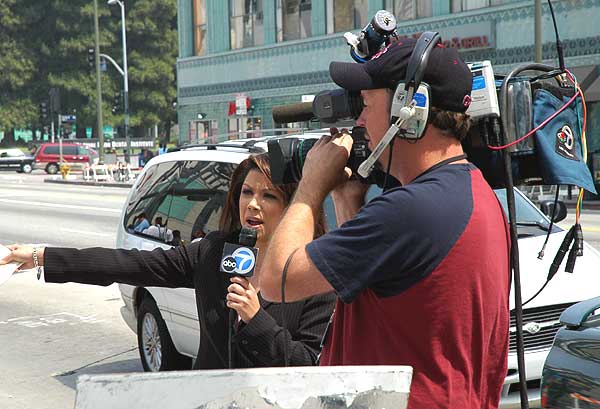
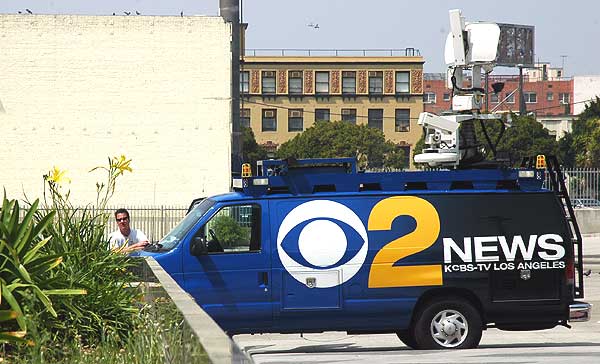
Police presence –
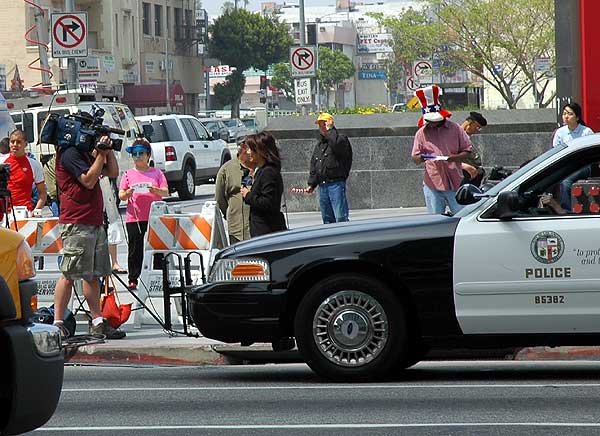
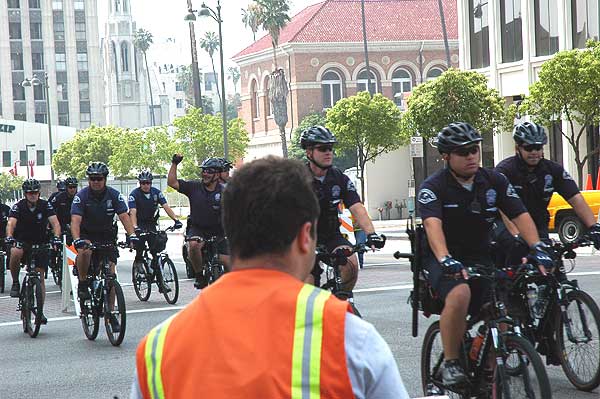
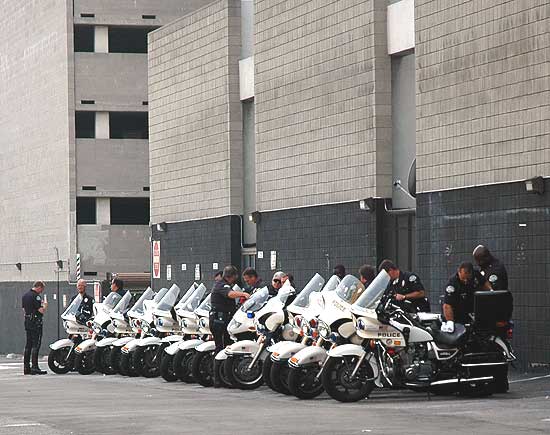
Businesses were closed,
and a rare shot of Wilshire Boulevard absolutely empty in the middle of a Monday afternoon –
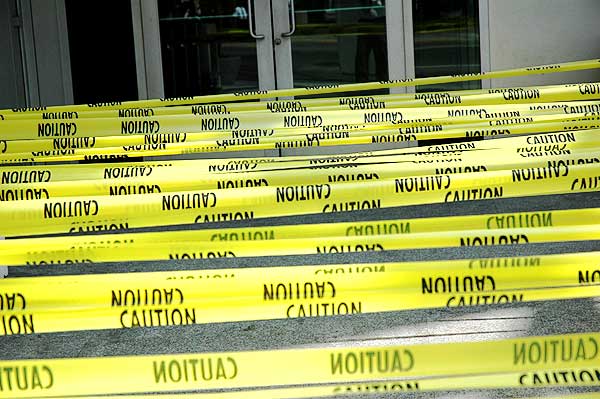
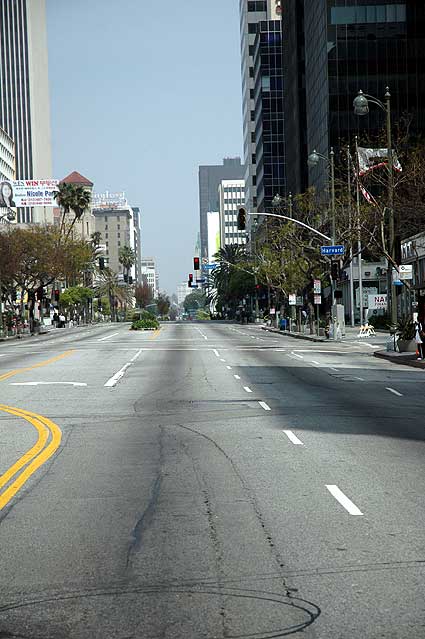
For a bit of history see The Roots of May Day, from Nelson Lichtenstein, posted at SLATE.COM the same say. Lichtenstein is a professor of history up the coast at UC Santa
Barbara, where he directs the Center for Work, Labor, and Democracy.
Here's a bit of what he has to say -
...
These May Day demonstrations and boycotts return the American protest tradition to its turn-of-the-20th-century ethnic proletarian
origins - a time when, in the United States as well as in much of Europe, the quest for citizenship and equal rights was inherent
in the fight for higher wages, stronger unions, and more political power for the working class.
Because today's marches
are on a workday, they recall the mass strikes and marches that turned workers out of factories that convulsed America in
the decades after the great railway strike of 1877, the first national work stoppage in the United States. Asserting their
citizenship against the autocracy embodied by the big railroad corporations, the Irish and Germans of Baltimore and Pittsburgh
burned roundhouses and fought off state militia in a revolt that frightened both the rail barons and the federal government.
Hence the 19th-century construction of all those center-city National Guard armories, with rifle slits designed to target
unruly crowds. The protesters wanted not only higher pay and a recognized trade union but a new birth of egalitarian freedom.
Indeed, May Day itself, as an international workers holiday, arose out of a May 1, 1886, Chicago strike for the eight-hour
workday. The fight for leisure - clearly lost today - was a great unifying aspiration of the immigrant workers movement a
century ago with its slogan, "eight hours for work, eight hours for sleep, eight hours for what we will."
The largest
mobilization of immigrant workers in U.S. history occurred in 1919, when President Woodrow Wilson's rhetorical celebration
of self-determination and "industrial democracy," or self-rule at the workplace, echoed across steel districts from Homestead,
Pa., to Gary, Ind. Strike organizers printed their handbills in 15 different languages. Immigrant churches and working-class
lodge halls served as soup kitchens. The strikers called the mounted police "Cossacks." All these eruptions, which would successfully
Americanize millions of immigrants in the 1930s, blended trade unionism, ethnic self-consciousness, and the demand for full
citizenship. That unity proved essential for a long season of New Deal hegemony. And that's why this spring's awakening of
a new generation of immigrant working-class half-citizens holds such promise for liberals.
The last of these great
labor-strike demonstrations came in 1947. On an April workday, the United Automobile Workers flooded Detroit's Cadillac Square
with more than a quarter million of its members to protest congressional enactment of the Taft-Hartley Act, which curbed union
strike power and disqualified radicals from labor leadership. Most laborites called Taft-Hartley a "slave labor law." Then
as now, the leaders of the demonstration were divided over tactics. The left, and not just those oriented toward the Communists,
wanted to shut down the factories so that American unions could deploy, as one top UAW officer put it, "the kind of political
power which is most effective in Europe." More cautious unionists, led by UAW President Walter Reuther, sought a huge demonstration
but one that began only after workers clocked out for the day. Capitalizing on these internal divisions, and on the early
Cold War hostility to labor radicalism and political insurgency, the auto companies took their pound of flesh. They fired
key militants and cut off the tradition of white, working-class strike demonstrations in industrial cities for the rest of
the 20th century.
For our generation, as for the one before it, the idea that we might change the conditions of work
life and the structure of politics has seemed either radical fantasy or Parisian self-indulgence. Celebrations of May Day,
the holiday that embodies that imagined link, have been consigned to the most self-conscious and marginal radicals. In 1958,
President Dwight D. Eisenhower proclaimed May 1 "Law Day" so as to snuff out any proletarian embers that might have continued
to smolder through the Cold War.
The 1960s civil rights and anti-war movements kept their distance from workplace
actions, which became the province of an increasingly stolid and constrained trade unionism. The protests of that era were
almost always held on weekends. The 1963 March on Washington, where Martin Luther King Jr. gave his "I Have a Dream" speech,
took place on a sweltering Saturday afternoon. There were plenty of protest signs paid for by the union movement, but no factories
shut down that day. The same is true of the big anti-war marches, and American feminists and gay-rights advocates have continued
that tradition. The linkage between workplace protest and civil engagement has been broken - one reason that the boycotts
and work stoppages today seem so novel and controversial.
When weekday work stoppages did take place, their marginality,
and even alienation, from mainstream America was revealing. Arab workers put down their tools in June 1967 to protest U.S.
support of Israel in the midst of the Six Day War. Millions of black workers left work when they learned of MLK's assassination
on April 4, 1968, but black power efforts to use the strike to build a radical movement on the assembly lines largely failed
in Detroit a year later. Today's marches and boycotts are restoring to May Day something of its old civic meaning and working-class
glory. Even some of the most viciously anti-union employers of Latino labor, like Perdue, Cargill, and Tyson Foods, kept their
factories closed. As in the crucial struggles that began more than a century ago, today's marches have forged a link among
working-class aspiration, celebrations of ethnic identity, and insistence on full American citizenship. It's an explosive
combination. And it could revive and reshape liberal politics in our time.
Perhaps so. So consider
this image.
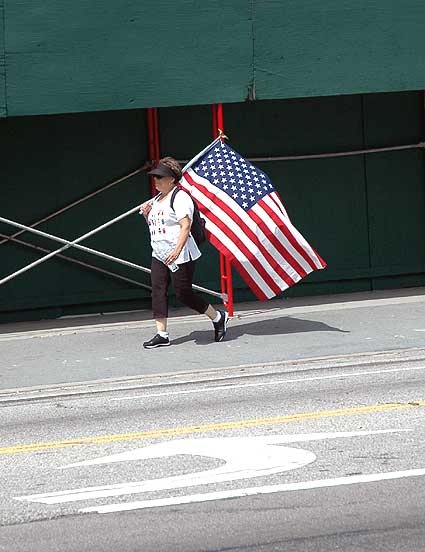
|

|

|

